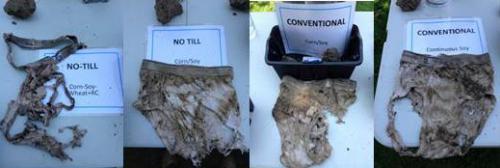Spring 2016 field crop soil update for southwest Michigan
Soil biology positively impacts chemical and physical properties and is key to healthy soils.
Soil health stands on a three-legged stool: good chemical, physical/structural and biological characteristics. Although most farmers are familiar with and test for chemical health, i.e. soil nutrient sufficiency and, to some extent, good soil structure, fewer understand the biological aspect and how this can help build resilient soils. During an integrated pest management (IPM) breakfast meeting on June 14, 2016, in St. Joseph County, Tom Shibley, a sales consultant with Midwestern BioAg, explained how each of these is important, how they interact and how farmers can improve their soils in each of these areas.
Common soil chemistry indicators include cation exchange capacity (CEC), organic matter, pH and base saturation. Base saturation and pH can be managed with soil amendments such as lime and different fertilizer formulations. Organic matter and CEC are often highly correlated and are dependent on soil type. However, certain farming practices can increase both of these over time. Shibley explained how incorporating more carbon into the soil - through crop residues, cover crops and compost/manure - tilling only when needed and applying nitrogen only as needed can increase soil organic carbon over time, although he noted that this buildup can take five to 10 years or more. Michigan State University Extension has produced numerous articles highlighting the importance of soil organic matter (Advanced Soil Organic Matter Management (E3137), “Manure and soil organic matter”, “Compost increases the water holding capacity of droughty soils”, “Cover crops and soil organic matter”, “Increasing organic matter can reduce soil compaction in sugarbeets”) and the benefits of good tillage practices (“Tillage practices have a direct correlation to soil health”, “Measure residue cover to protect the soil”, “Manage cropping systems to reduce compaction and restore soil quality and productivity”). Providing microfauna (e.g. bacteria, fungi), mesofauna (e.g. beneficial nematodes) and macrofauna (e.g. earthworms, arthropods) with a continual source of carbon, nitrogen and other essential nutrients will build soil that is resilient to erosion, drought and other plant stresses.
Soil structure refers to how soil particles are grouped together to form aggregates and is also highly correlated with soil type. Generally speaking, tillage breaks apart soil aggregates and can lead to fewer soil pore spaces; this can result in lower water infiltration rates and can restrict root penetration, particularly in heavier soils. Shibley said soil that feels like coffee grounds that are aggregated is an ideal structure. He explained that certain soil biological processes help to build soil structure. For example, exudates from fungi, bacteria and plant roots act as an organic glue to cement particles together, and fungal hyphae and plant fine roots also stabilize aggregates.
How do you know if your soil is “healthy”? Shibley suggested five tests farmers can use. First, a standard soil test will provide information on soil chemistry. The MSU Soil and Plant Nutrient Lab performs a number of different soil test packages as do many other labs in the Midwest. Second, the aggregate stability test (as described in “Target tillage to protect the soil”) will show whether soil aggregates are adequately formed in your soil. The shovel test (how easy it is to step a shovel into the soil) and smell test (should smell fresh, sweet, pleasant) are two other qualitative measurements that are low-tech but can be very useful. The cotton underwear (or “tighty whitey”) test is an indicator of soil biological health. Burying a pair of cotton briefs near the soil surface for a couple of months and visually assessing how degraded the fabric is (Fig. 1) will give you a sense of how active the biological community is in your soil.

Fig. 1. The “underwear test” for soil biological health. Photo: Ontario Ministry of Agriculture, Food and Rural Affairs (OMAFRA).
The St. Joseph County IPM Breakfast Series is organized by the MSU Extension field crops team in southwest Michigan. The meetings run through the end of June and are held on Tuesdays at the Royal Café in Centreville, Michigan, beginning at 7 a.m. Each meeting includes an update of the major field crops grown in the region, including a crop and pest report, followed by a presentation from a guest speaker on a topic important to crop production. Participants can order breakfast and eat during the meeting.
The speakers for June 21, 2016, will be Tony Belcher with Koviack Irrigation & Farm Services and Wally Hekter with Legacy Land Farms, Inc. who will be addressing the topic “Irrigation: Experiences with Soil Moisture Monitors and Schedulers.” The meeting will be sponsored by Mike Schrock with Advanced Farm Supply, Inc. and the Monsanto Company. Meetings are open to the public, and CEU and RUP credits will be available. For more information on this breakfast meeting series, contact Eric Anderson at the MSU Extension St. Joseph County office at 269-467-5511.



 Print
Print Email
Email


